Abstract
1. Oxygen consumption, respiratory frequency, and temperatures of the rectum, common carotid artery, external auditory meatus, and skin on the ears, near the distal end of the metacarpus and metatarsus, upper thigh and mid-side of the body, were measured in five rams before, during and after heating the scrotum. Effects on the woolly animal exposed to ambient temperatures of 17-19° C, and on the shorn animal exposed to ambient temperatures of 5·6-24·5° C, were determined.
2. In eight experiments on woolly animals scrotal heating resulted in vigorous panting and a lowering of deep body temperatures by 0·3-1·1° C within 50 min. There was no significant change in oxygen consumption or body skin and upper thigh temperature. Changes in skin temperature of the extremities indicated, on average, a vasodilator response to heating. However, individual responses were unpredictable, there sometimes being dilation and constriction in different extremities of the same animal.
3. In twelve experiments on shorn animals in environments below 20° C, oxygen consumption before scrotal heating was higher than when the animal was woolly. Scrotal heating resulted in a fall in oxygen consumption and a lowering of deep body temperatures by 0·2-0·9° C within 50 min. There was no change in respiratory frequency or body skin and upper thigh temperature. As in the woolly animal, vasomotor responses were disorganized, although there was a tendency towards vasodilation.
4. In three shorn animals in environments of 20·5 and 24·5° C, oxygen consumption before scrotal heating was only slightly higher than when the animal was woolly. In two of these animals (in 20·5 and 24·5° C) scrotal heating resulted in a slight lowering of oxygen consumption and mild panting, and deep body temperature fell by 0·9° C in 50 min. In the third animal (in 24·5° C) there was no change in oxygen consumption but vigorous panting and vasodilation, and deep body temperature fell by 1·3° C in 50 min.
5. In a number of experiments on shorn animals scrotal heating was continued for more than 100 min. Deep body temperature was controlled at a new low level after the initial fall, and the possibility of a resetting of the `set-point' temperature is discussed.
6. The previously unexplained fall in body temperature of the shorn ram in which panting did not follow scrotal heating may now be mainly ascribed to a reduction in metabolic rate. Also, the possible role of cutaneous evaporation should not be discounted. The inhibition of panting in the shorn sheep at environmental temperatures below 20° C remains unexplained.
7. Body heating alone, by covering the shorn animal with a sheep skin coat in an environment of 19° C, elicited well organized vasomotor changes in the ears and lower legs.
8. As a result of the present study and previous work by others, it is clear that all thermoregulatory mechanisms, with the exception of vasomotor changes, may be influenced in a predictable manner by temperature changes of the scrotum.
Full text
PDF

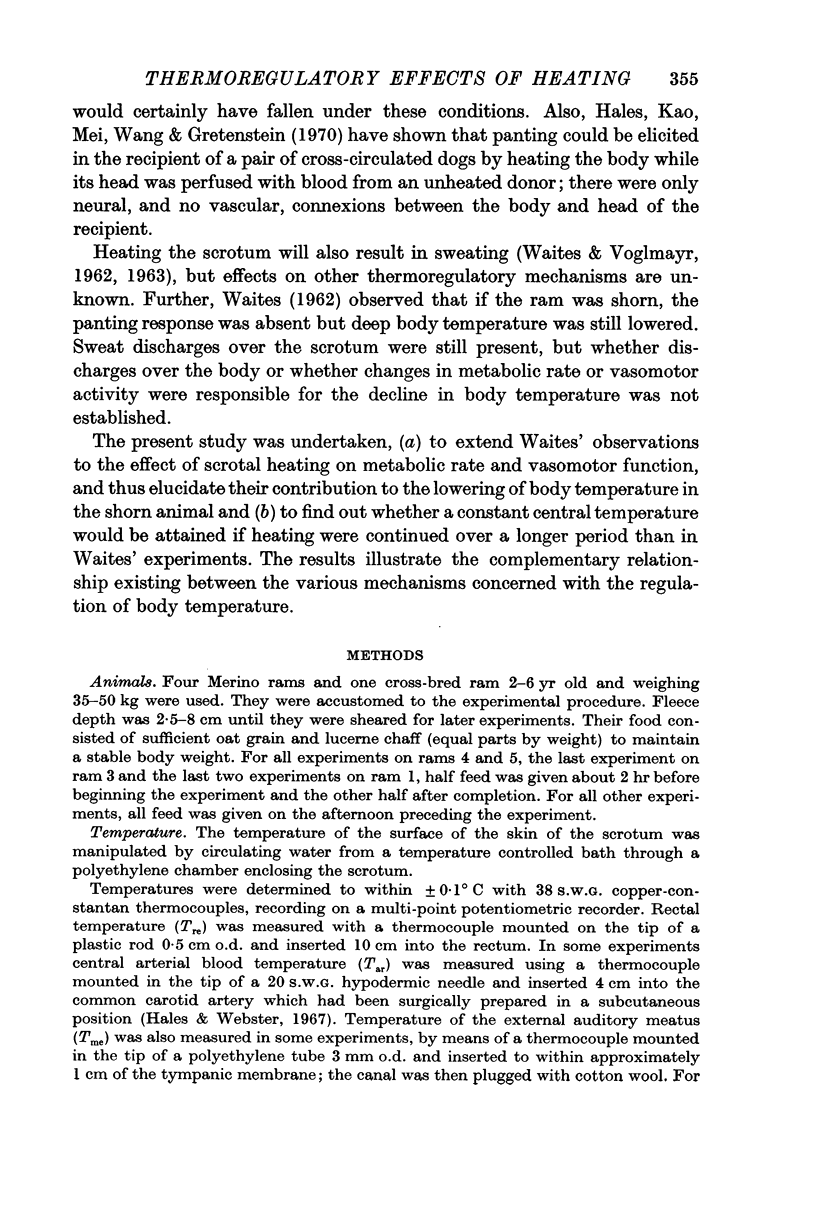
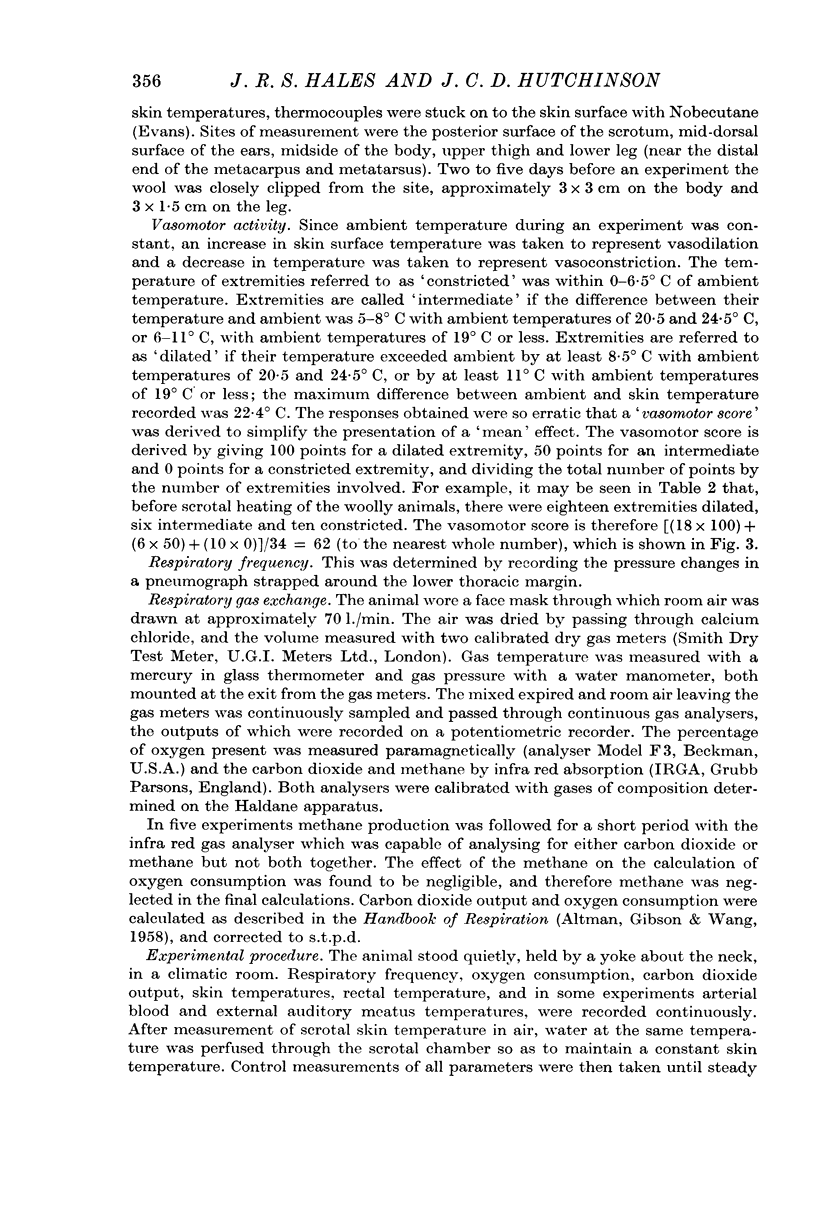
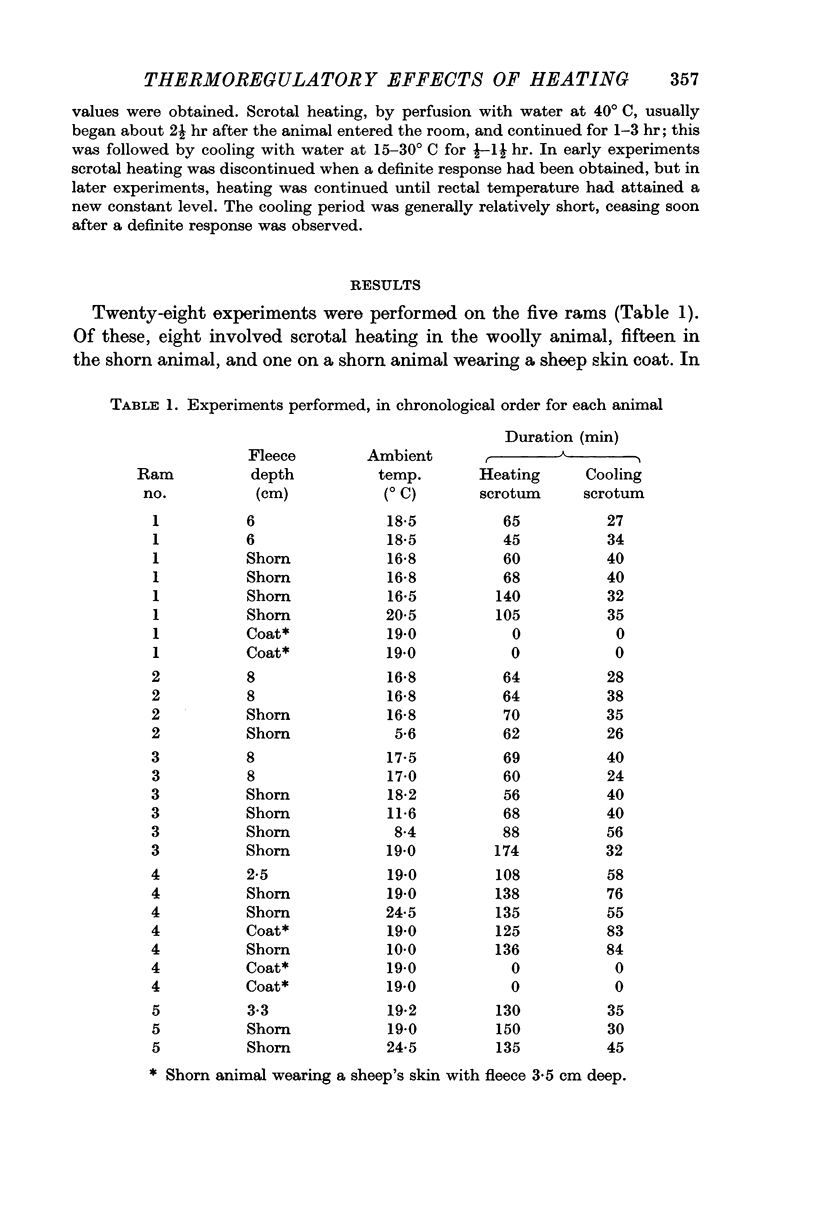



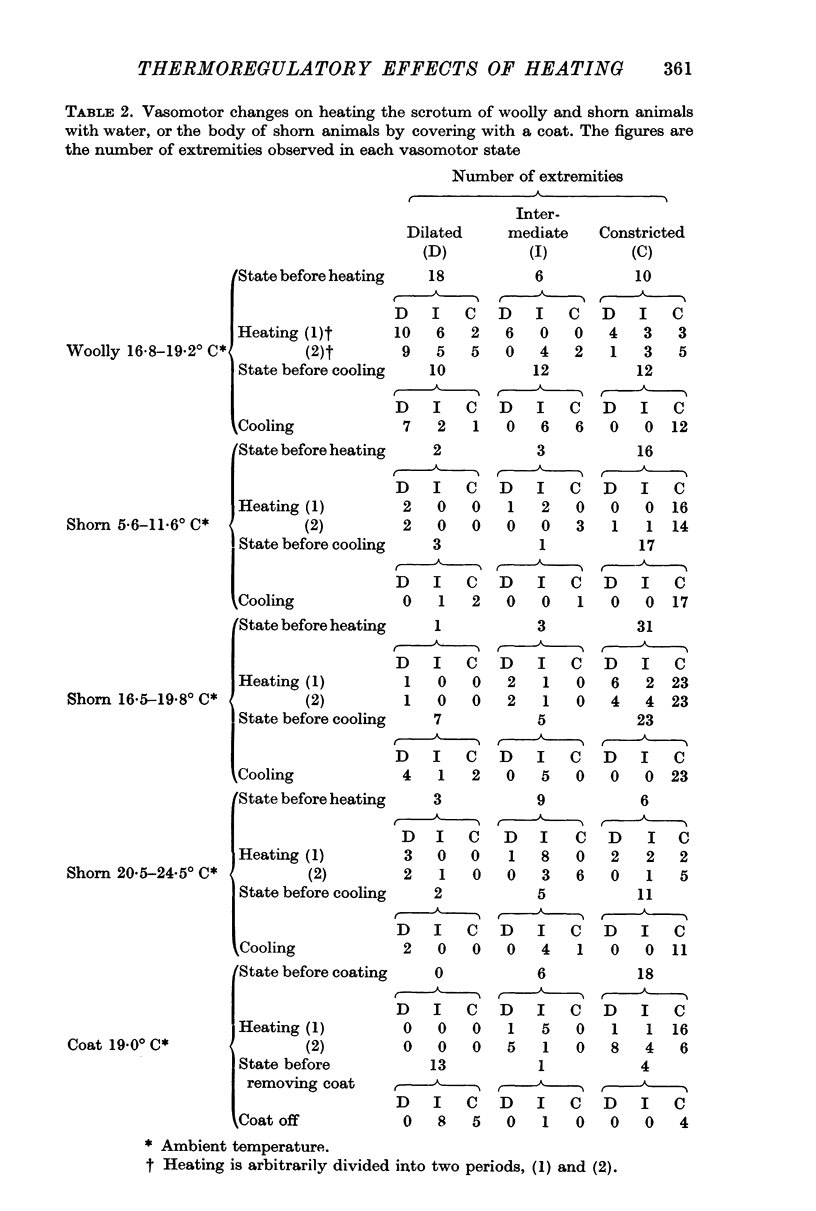
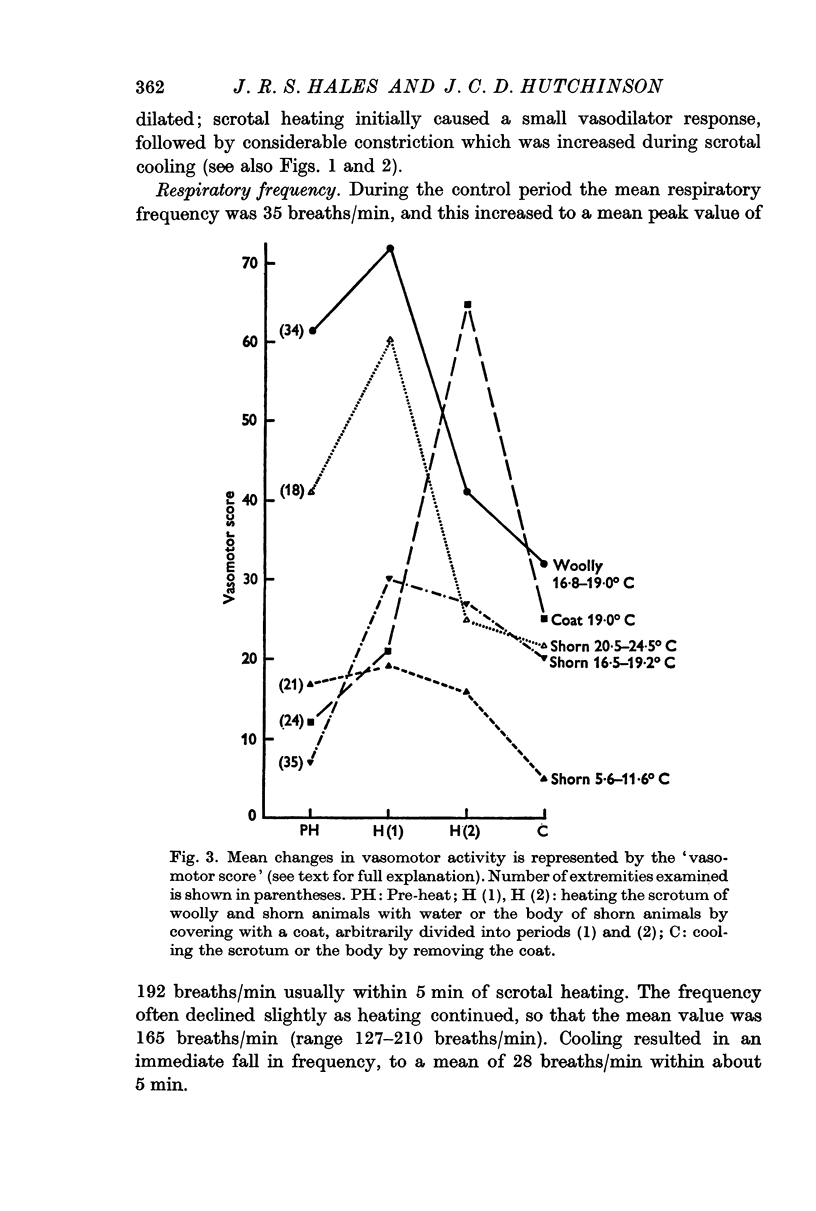
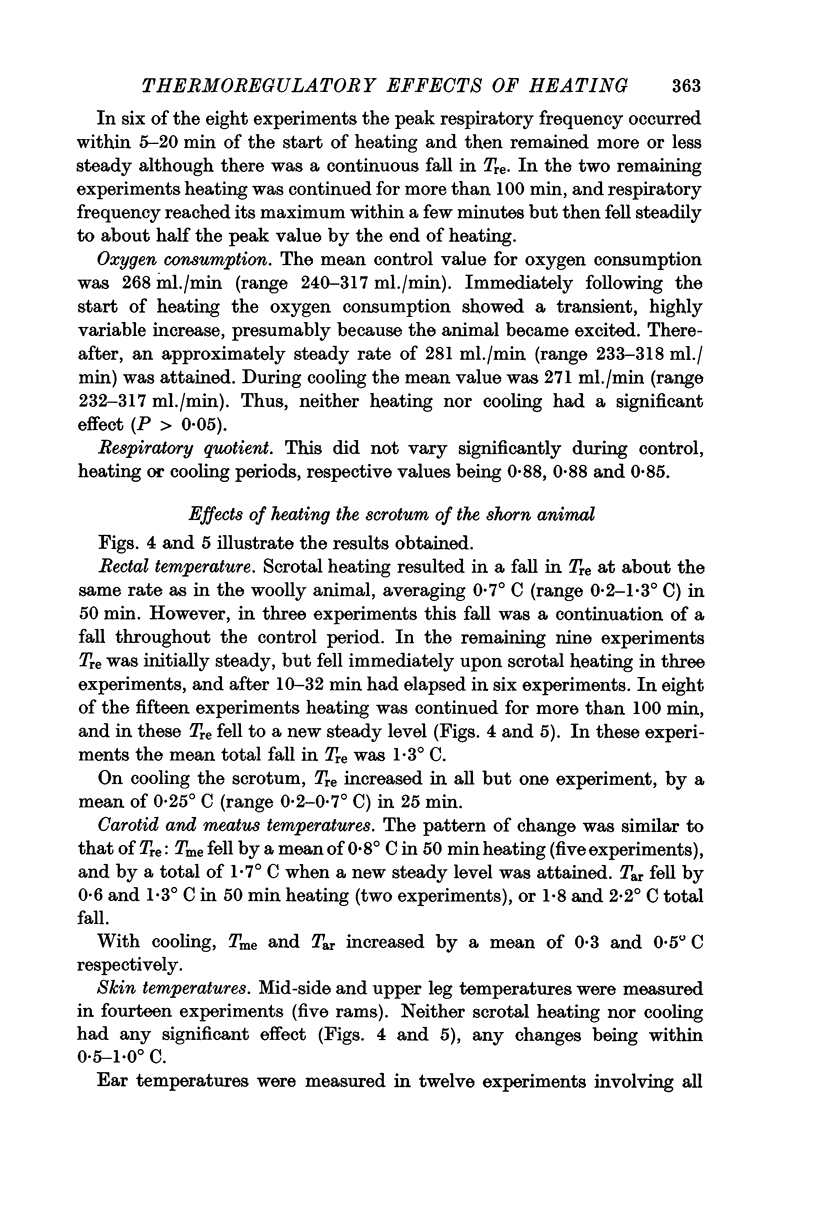
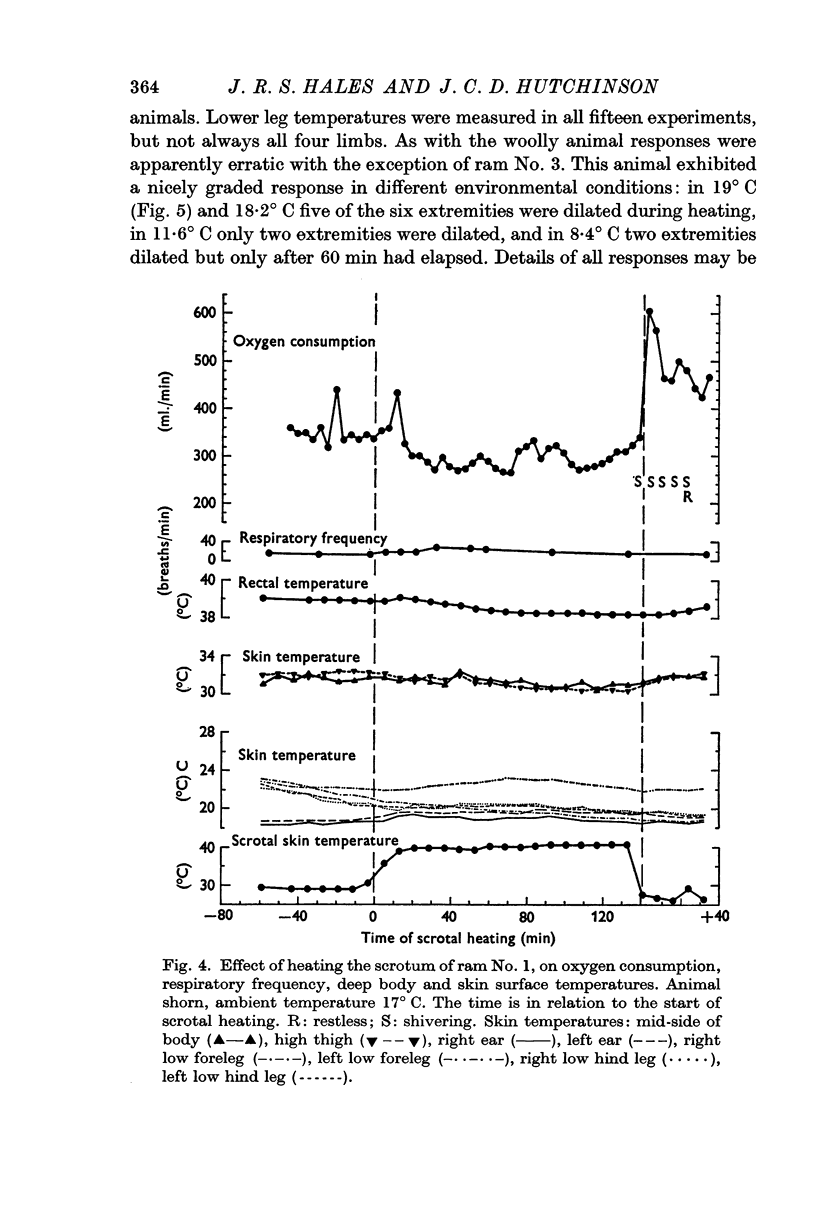
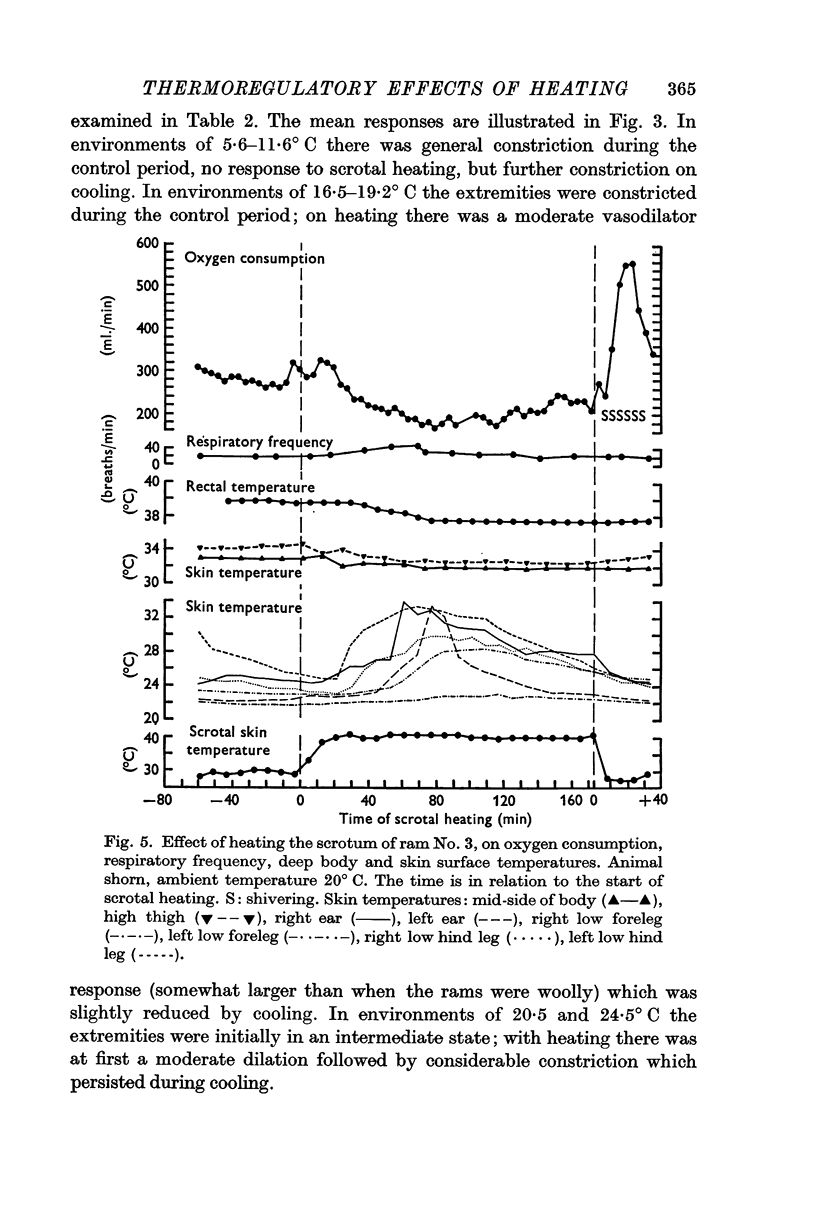
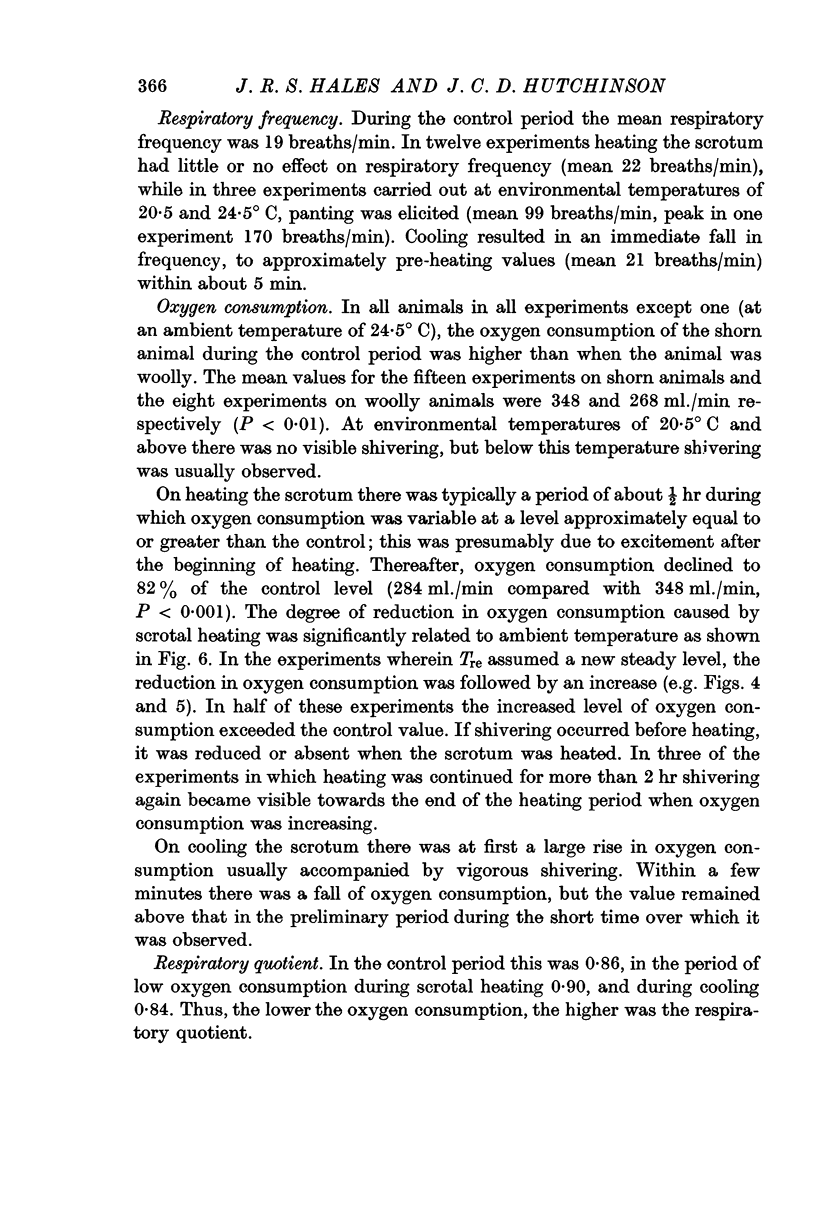

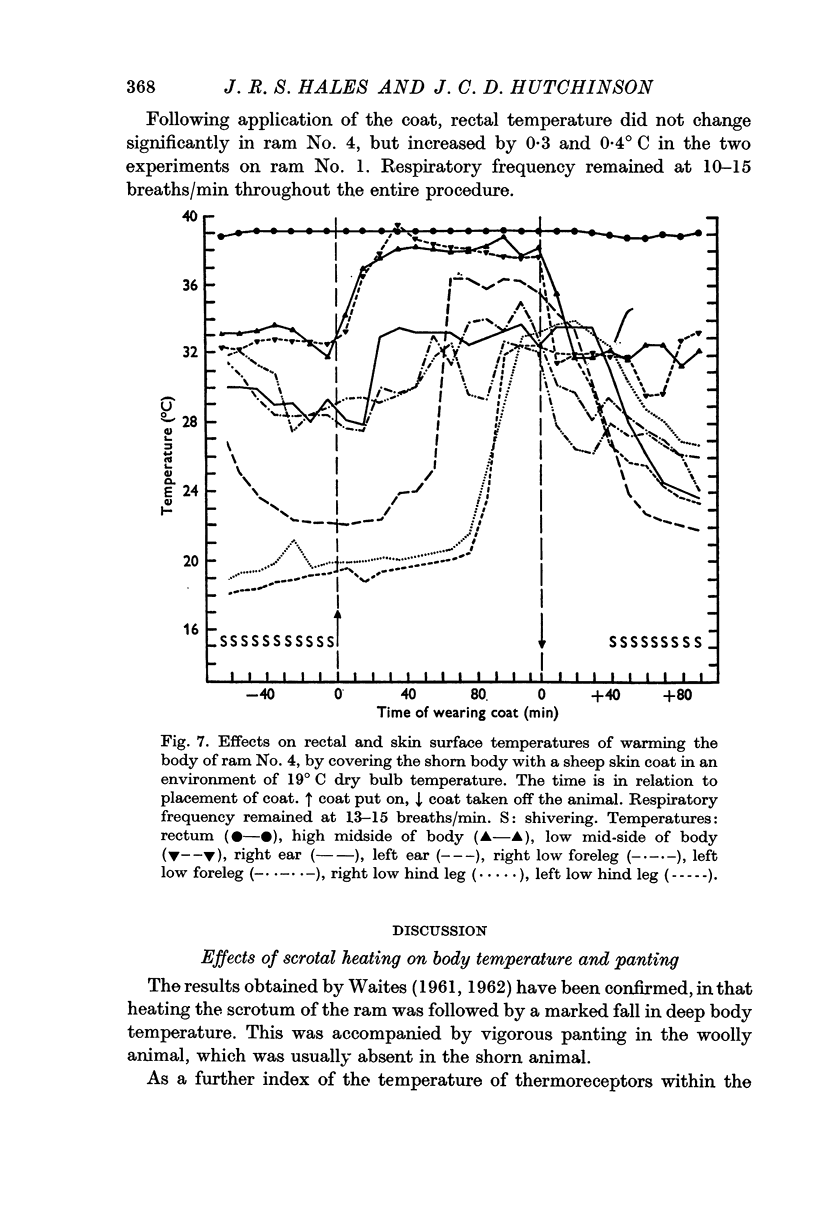
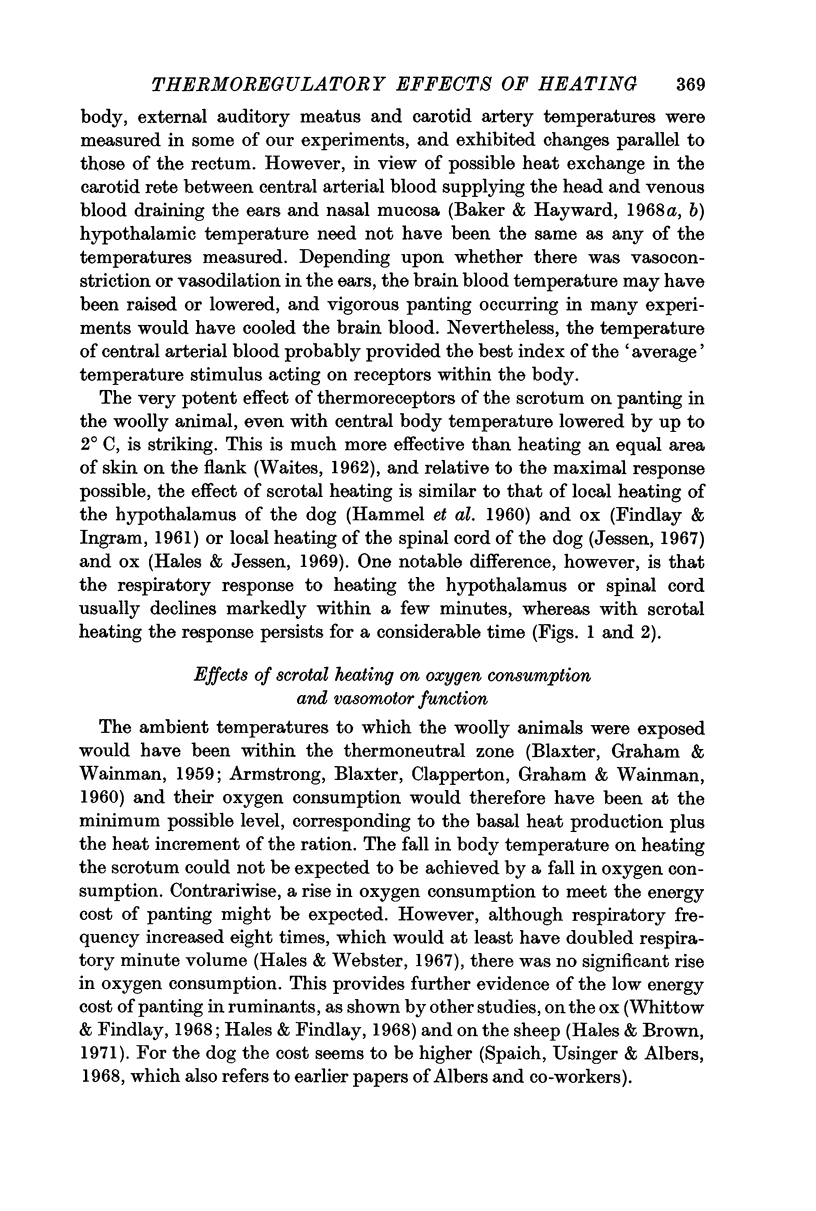

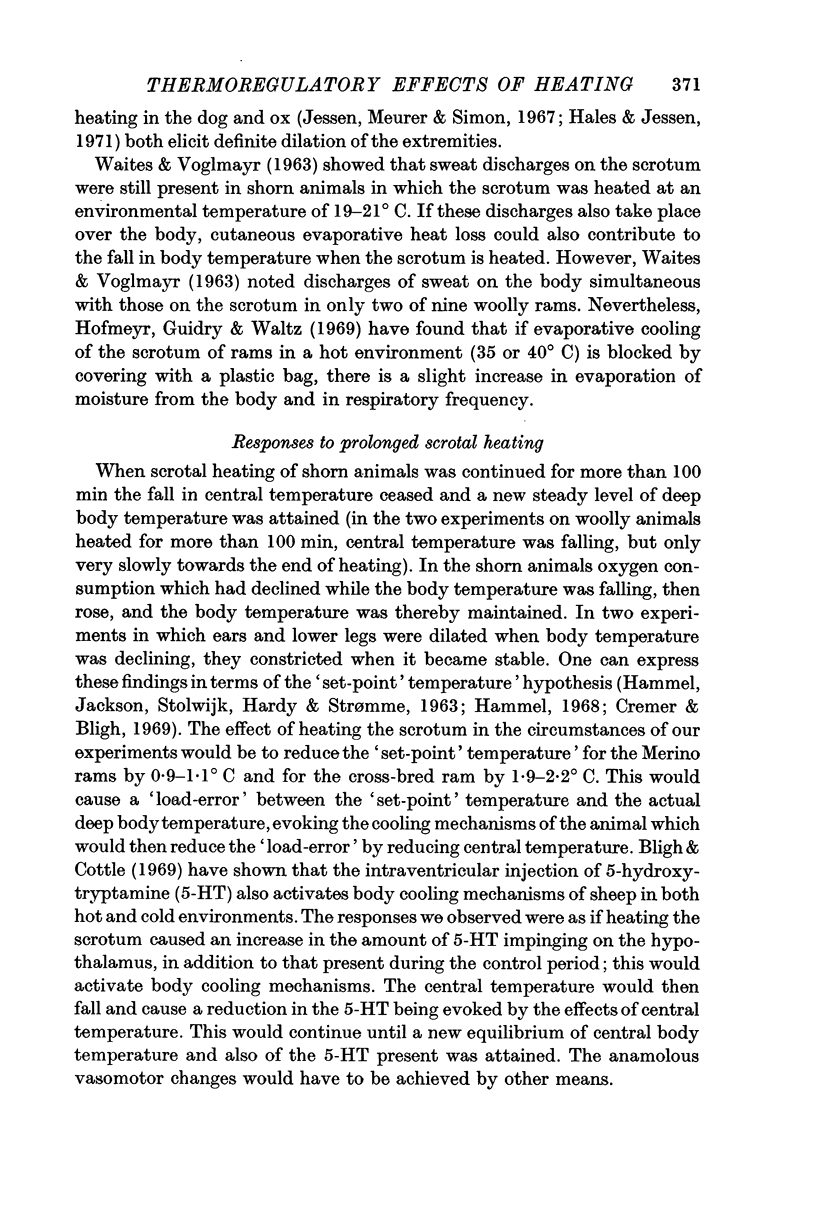

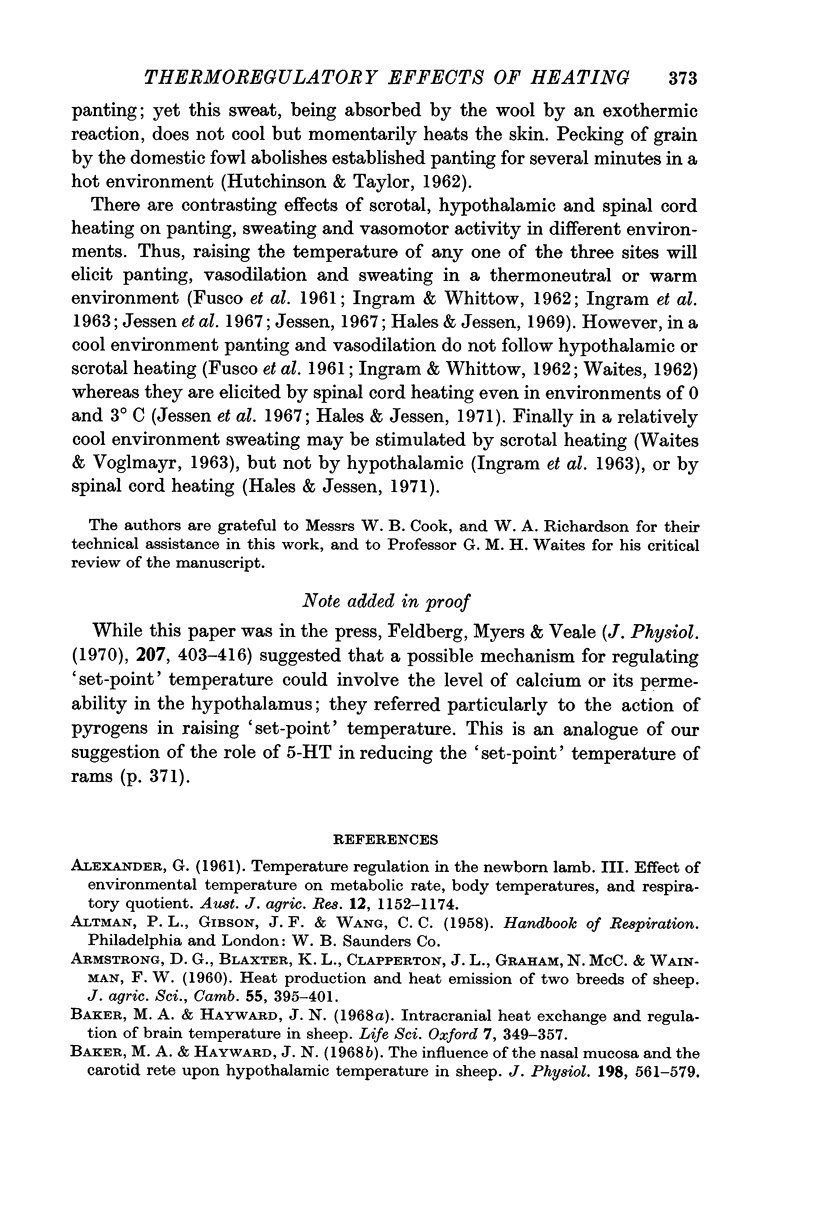
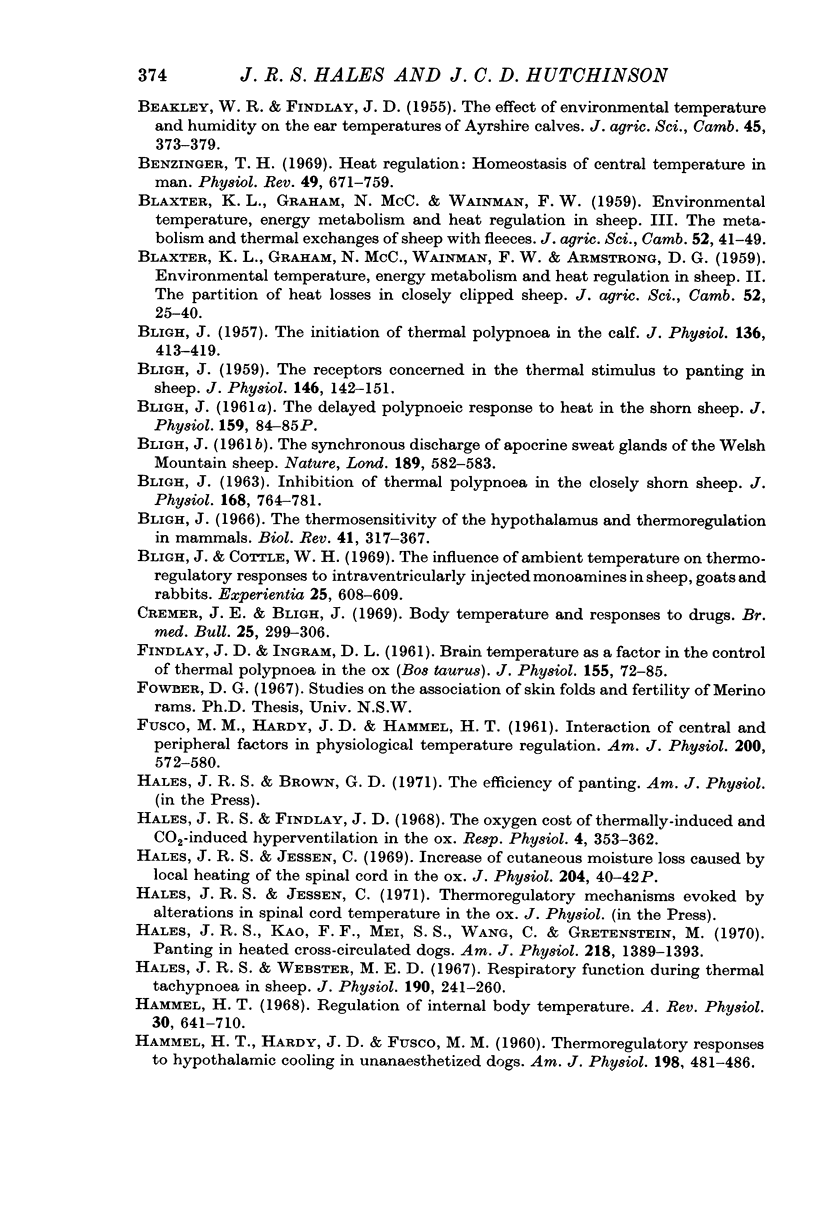

Selected References
These references are in PubMed. This may not be the complete list of references from this article.
- BLIGH J. INHIBITION OF THERMAL POLYPNOEA IN THE CLOSELY SHORN SHEEP. J Physiol. 1963 Oct;168:764–781. doi: 10.1113/jphysiol.1963.sp007221. [DOI] [PMC free article] [PubMed] [Google Scholar]
- BLIGH J. The initiation of thermal polypnoea in the calf. J Physiol. 1957 Apr 30;136(2):413–419. doi: 10.1113/jphysiol.1957.sp005770. [DOI] [PMC free article] [PubMed] [Google Scholar]
- BLIGH J. The receptors concerned in the thermal stimulus to panting in sheep. J Physiol. 1959 Apr 23;146(1):142–151. doi: 10.1113/jphysiol.1959.sp006184. [DOI] [PMC free article] [PubMed] [Google Scholar]
- Baker M. A., Hayward J. N. Intracranial heat exchange and regulation of brain temperature in sheep. Life Sci. 1968 Apr 1;7(7):349–357. doi: 10.1016/0024-3205(68)90003-9. [DOI] [PubMed] [Google Scholar]
- Baker M. A., Hayward J. N. The influence of the nasal mucosa and the carotid rete upon hypothalamic temperature in sheep. J Physiol. 1968 Oct;198(3):561–579. doi: 10.1113/jphysiol.1968.sp008626. [DOI] [PMC free article] [PubMed] [Google Scholar]
- Benzinger T. H. Heat regulation: homeostasis of central temperature in man. Physiol Rev. 1969 Oct;49(4):671–759. doi: 10.1152/physrev.1969.49.4.671. [DOI] [PubMed] [Google Scholar]
- Bligh J., Cottle W. H. The influence of ambient temperature on thermoregulatory responses to intraventricularly injected monoamines in sheep, goats and rabbits. Experientia. 1969 Jun 15;25(6):608–609. doi: 10.1007/BF01896541. [DOI] [PubMed] [Google Scholar]
- Bligh J. The thermosensitivity of the hypothalamus and thermoregulation in mammals. Biol Rev Camb Philos Soc. 1966 Aug;41(3):317–368. doi: 10.1111/j.1469-185x.1966.tb01496.x. [DOI] [PubMed] [Google Scholar]
- Cremer J. E., Bligh J. Body-temperature and responses to drugs. Br Med Bull. 1969 Sep;25(3):299–306. doi: 10.1093/oxfordjournals.bmb.a070722. [DOI] [PubMed] [Google Scholar]
- FINDLAY J. D., INGRAM D. L. Brain temperature as a factor in the control of thermal polypnoea in the ox (Bos taurus). J Physiol. 1961 Jan;155:72–85. doi: 10.1113/jphysiol.1961.sp006614. [DOI] [PMC free article] [PubMed] [Google Scholar]
- FUSCO M. M., HARDY J. D., HAMMEL H. T. Interaction of central and peripheral factors in physiological temperature regulation. Am J Physiol. 1961 Mar;200:572–580. doi: 10.1152/ajplegacy.1961.200.3.572. [DOI] [PubMed] [Google Scholar]
- Feldberg W., Myers R. D., Veale W. L. Perfusion from cerebral ventricle to cisterna magna in the unanaesthetized cat. Effect of calcium on body temperature. J Physiol. 1970 Apr;207(2):403–416. doi: 10.1113/jphysiol.1970.sp009069. [DOI] [PMC free article] [PubMed] [Google Scholar]
- HAMMEL H. T., HARDY J. D., FUSCO M. M. Thermoregulatory responses to hypothalamic cooling in unanesthetized dogs. Am J Physiol. 1960 Mar;198:481–486. doi: 10.1152/ajplegacy.1960.198.3.481. [DOI] [PubMed] [Google Scholar]
- HAMMEL H. T., JACKSON D. C., STOLWIJK J. A., HARDY J. D., STROMME S. B. TEMPERATURE REGULATION BY HYPOTHALAMIC PROPORTIONAL CONTROL WITH AN ADJUSTABLE SET POINT. J Appl Physiol. 1963 Nov;18:1146–1154. doi: 10.1152/jappl.1963.18.6.1146. [DOI] [PubMed] [Google Scholar]
- HARRISON R. G., WEINER J. S. Vascular patterns of the mammalian testis and their functional significance. J Exp Biol. 1949 Oct;26(3):304-16, 2 pl. doi: 10.1242/jeb.26.3.304. [DOI] [PubMed] [Google Scholar]
- Hales J. R., Findlay J. D. The oxygen cost of thermally-induced and CO2-induced hyperventilation in the ox. Respir Physiol. 1968 May;4(3):353–362. doi: 10.1016/0034-5687(68)90040-6. [DOI] [PubMed] [Google Scholar]
- Hales J. R., Jessen C. Increase of cutaneous moisture loss caused by local heating of the spinal cord in the ox. J Physiol. 1969 Sep;204(1):40P–42P. [PubMed] [Google Scholar]
- Hales J. R., Kao F. F., Mei S. S., Wang C., Gretenstein M. Panting in heated cross-circulated dogs. Am J Physiol. 1970 May;218(5):1389–1393. doi: 10.1152/ajplegacy.1970.218.5.1389. [DOI] [PubMed] [Google Scholar]
- Hales J. R., Webster M. E. Respiratory function during thermal tachypnoea in sheep. J Physiol. 1967 May;190(2):241–260. doi: 10.1113/jphysiol.1967.sp008205. [DOI] [PMC free article] [PubMed] [Google Scholar]
- Hammel H. T. Regulation of internal body temperature. Annu Rev Physiol. 1968;30:641–710. doi: 10.1146/annurev.ph.30.030168.003233. [DOI] [PubMed] [Google Scholar]
- Hofmeyr H. S., Guidry A. J., Waltz F. A. Effects of temperature and wool length on surface and respiratory evaporative losses of sheep. J Appl Physiol. 1969 May;26(5):517–523. doi: 10.1152/jappl.1969.26.5.517. [DOI] [PubMed] [Google Scholar]
- INGRAM D. L., MCLEAN J. A., WHITTOW G. C. THE EFFECT OF HEATING THE HYPOTHALAMUS AND THE SKIN ON THE RATE OF MOISTURE VAPORIZATION FROM THE SKIN OF THE OX (BOS TAURUS). J Physiol. 1963 Nov;169:394–403. doi: 10.1113/jphysiol.1963.sp007264. [DOI] [PMC free article] [PubMed] [Google Scholar]
- INGRAM D. L., WHITTOW G. C. The effect of heating the hypothalamus on respiration in the ox (Bos taurus). J Physiol. 1962 Sep;163:200–210. doi: 10.1113/jphysiol.1962.sp006968. [DOI] [PMC free article] [PubMed] [Google Scholar]
- Jessen C. Auslösung von Hecheln durch isolierte Wärmung des Rückenmarks am wachen Hund. Pflugers Arch Gesamte Physiol Menschen Tiere. 1967;297(2):53–70. [PubMed] [Google Scholar]
- Jessen C., Meurer K. A., Simon E. Steigerung der Hautdurchblutung durch isolierte Wärmung des Rückenmarks am wachen Hund. Pflugers Arch Gesamte Physiol Menschen Tiere. 1967;297(2):35–52. [PubMed] [Google Scholar]
- SETCHELL B. P., WAITES G. M. BLOOD FLOW AND THE UPTAKE OF GLUCOSE AND OXYGEN IN THE TESTIS AND EPIDIDYMIS OF THE RAM. J Physiol. 1964 Jun;171:411–425. doi: 10.1113/jphysiol.1964.sp007387. [DOI] [PMC free article] [PubMed] [Google Scholar]
- Sihler C. On the so-called Heat-Dyspnoea. J Physiol. 1879 Sep;2(3):191–201. doi: 10.1113/jphysiol.1879.sp000056. [DOI] [PMC free article] [PubMed] [Google Scholar]
- Spaich P., Usinger W., Albers C. Oxygen cost of panting in anaesthetized dogs. Respir Physiol. 1968 Sep;5(2):302–314. doi: 10.1016/0034-5687(68)90068-6. [DOI] [PubMed] [Google Scholar]
- WAITES G. M., MOULE G. R. Relation of vascular heat exchange to temperature regulation in the testis of the ram. J Reprod Fertil. 1961 Aug;2:213–224. doi: 10.1530/jrf.0.0020213. [DOI] [PubMed] [Google Scholar]
- WAITES G. M. Polypnoea evoked by heating the scrotum of the ram. Nature. 1961 Apr 8;190:172–173. doi: 10.1038/190172a0. [DOI] [PubMed] [Google Scholar]
- WAITES G. M., VOGLMAYR J. K. Apocrine sweat glands of the scrotum of the ram. Nature. 1962 Dec 8;196:965–967. doi: 10.1038/196965a0. [DOI] [PubMed] [Google Scholar]
- WEBSTER M. E., JOHNSON K. G. DISTRIBUTION OF TEMPERATURE IN THE SKIN OF SHEEP EXPOSED TO MODERATE ENVIRONMENTS. Nature. 1964 Jan 11;201:208–209. doi: 10.1038/201208a0. [DOI] [PubMed] [Google Scholar]
- Whittow G. C., Findlay J. D. Oxygen cost of thermal panting. Am J Physiol. 1968 Jan;214(1):94–99. doi: 10.1152/ajplegacy.1968.214.1.94. [DOI] [PubMed] [Google Scholar]


